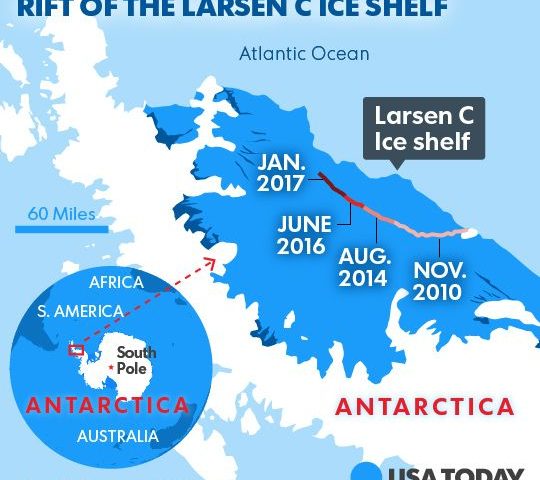Blog
The Larsen C ice shelf has broken free into the Southern Ocean
It is also well-timed politically. Larsen C has broken off just a month or so after President Trump withdrew the U.S. from the Paris climate agreement when people around the world are wondering just how much time we have left before the climate spins out of control – and what to do about it. A story in New York magazine about how climate change is cooking the planet kicked up a lot of debate about the usefulness of fear in inspiring political change. Meanwhile, the responsibility for the Larsen C crack-up is already being doled out: Climate activists have launched a campaign to rename the now-liberated Larsen C ice shelf as the Exxon Knew 1 iceberg.
➽SEE MORE- top-10-amazing-lakes-in-world
The Larsen C ice shelf has broken free into the Southern Ocean
Wednesday, July 12, 2017
 |
Breaking of Larsen C Ice Shelf in Antarctica(Source) |
So the moment is here. After months of teasing scientists who have been watching a widening crack in the ice of Antarctica via satellite cameras and surveillance aircraft, a 2,200-square-mile ice shelf known as the Larsen C has finally broken free and is now adrift in the Southern Ocean. Given that Antarctica contains enough ice to raise sea levels about 220 feet, which would drown coastal cities and make Waterworld look less like a cheesy sci-fi movie than a grim prophecy, the break-up for Larsen C is certainly a big deal.
In the farthest reaches of Antarctica, a nightmare scenario of crumbling ice – and rapidly rising seas – could spell disaster for a warming planet.
But it's not necessarily a big deal in the way you might think. One reason the Larson C is getting a lot of attention is that it's a made-for-media crack-up, one that has played out in a visible, dramatic way over the last few months and weeks. The crack in the ice was easy to photograph, easy to understand, easy to worry about.
Topography of Antarctica
 |
| The Larsen C ice shelf has broken free into the Southern Ocean (NASA) |
But the break-up of Larsen C, in itself, is not what Penn State ice scientist Richard Alley calls an "end-of-the-world screaming hairy disaster conniption fit." For one thing, 2,200 square miles of ice may sound like a lot, but in the context of Antarctica, which is the size of the U.S. and Mexico combined, it's the continental equivalent of losing a fingernail. Second, the ice shelf was already floating, so when it breaks off and eventually melts, it won't contribute much to sea-level rise, just as ice in a glass of water doesn't raise the level as it melts. The land-based glaciers behind the ice shelf are of more concern – ice shelves work as buttresses, holding glaciers back from falling into the sea – but in the case of the Larsen C, they are not that big, and so even if they do speed up and begin sliding into the sea, the impact on sea levels will not be large. It's also not even clear that the break-up of the Larsen C is related to climate change – ice shelves grow and collapse all the time. It is part of the natural rhythm of ice sheets grow evolution.
➽SEE MORE- top-ten-amazing-geographical-features
➽SEE MORE- top-ten-amazing-geographical-features
But that doesn't mean that the crack-up of the Larsen C is inconsequential. If you are concerned about how the rapid warming of the climate can drive changes that will alter the planet as we know it, submerging billions of dollars of real estate and infrastructure and creating hundreds of millions of climate refugees, then Antarctica is one of the scariest places on the planet. (In fact, I've spent the last three years working on a new book called The Water Will Come about how sea level rise will reshape our world.) A few months ago, I outlined the risks of a rapid collapse of the ice sheets in Antarctica in a story about Thwaites Glacier in West Antarctica. The dynamics at work on Thwaites are far more complex than what we're seeing right now with the Larsen C. But if Thwaites really starts to go, we're headed for a future with 6,000-foot-high ice shelves collapsing into the sea and the dramatic sea level rise of as much as 10 feet. As Ohio State glaciologist Ian Howat told me earlier this year, "If there is going to be a climate catastrophe, it's probably going to start at Thwaites."
We are living at a scary moment, a time when even the best scientists are struggling to understand just how quickly and dramatically our world can change. Maybe the best way to think about the Larsen C is a prelude to the coming catastrophe and as a last-minute call to action. "The Larsen C is Mother Nature's warning flag," polar explorer Robert Swan said at the Sun Valley Institute's annual forum last week. “It's her way of saying, 'Hey, pay attention to what you're doing to the planet we all live on.'”
Previous article
Next article

